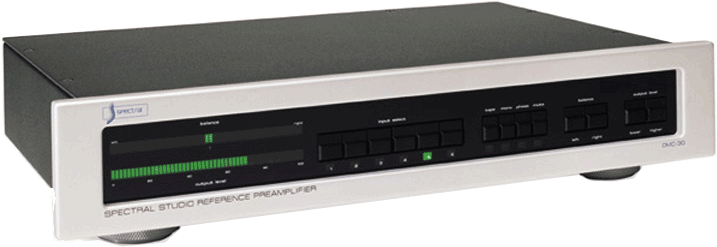


Spectral was founded in the belief that the world needed a better preamplifier, and that we knew how to make it. Our first product, the Spectral MS-ONE, introduced in 1976, was a radical departure from earlier premium preamplifier design and construction. Its true dual monaural topology featuring extremely fast and wideband all-FET circuitry represented an extraordinary rethinking of conventional ideas. Innovations like its direct-coupled circuits, moving-coil-ready phono stage and independent power supplies with AC line conditioning were made possible by the use of then-esoteric devices and techniques pioneered by advanced high technology disciplines such as instrumentation and microwave. The MS-ONE launched Spectral as "the audio maverick from Silicon Valley," a characterization which is still apt, although undergirded in the intervening years by numerous highly successful product introductions and the satisfaction of music enthusiasts all over the world.
Starting in 1990, the DMC-20 became Spectral's flagship preamplifier, bringing the original MS-ONE design philosophy to a new level of refinement and a widening audience. The DMC-20 continues today as an established reference instrument esteemed by many to be one of the great audio components of all time and a classic preamplifier design.
In the mid-1990s, Spectral determined that the time had come to take a fresh look at high performance design in light of new developments in audio technology and user preference. We embarked on the creation of an all new, full feature preamplifier based on clean sheet engineering. The DMC-30 is the result of this long and painstaking quest.
Above all, the DMC-30 had to be a lasting design. Spectral's lengthy product development programs and small scale, handcrafted production methods can only be justified by non-obsolescent, almost ageless designs. Designs characterized by state-of-the-art performance, durability and the capacity to evolve.
Such a design is the DMC-30.
CONVENIENCE WITHOUT COMPROMISE
THE MOVING FADER
THE STUDIO APPROACH
DMC-30 DESIGN FEATURES
THREE-TIERED ARCHITECTURE
LINE LEVEL GAIN STAGE
RELAY REFINEMENTS
OPTICAL PROTECTION CIRCUITRY
PROGRAMMED FEATURES
FUTURE PLANNING
IN THE SPECTRAL TRADITION